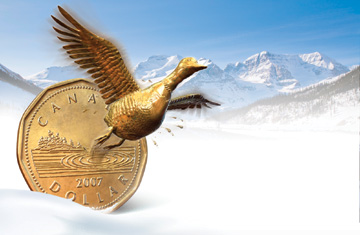
The day the Canadian dollar hit its all-time high was not, in fact, Nov. 7, 2007. The pinnacle came more than 140 years earlier, when Confederate troops reached the outskirts of Washington, D.C., forcing Union soldiers to decamp from Virginia and defend their capital. The Canadian dollar that day was worth $2.78 U.S.
It may seem, then, that the loonie's $1.10 U.S. mark in November — merely its peak in generations — should not have elicited quite the cheers and fears it did across the country. Canadians, of course, are peculiarly obsessed with the U.S. dollar exchange rate: three-quarters of exports go to the U.S. and a comparable share of imports arrive from there. But America's Civil War is a reminder, if nothing else, that when currencies start breaking records, it's usually a sign that something big is happening.
And something big was happening in Canada in 2007. The economy boomed even as that of its southern neighbor showed signs of cooling. The engines of Canadian growth are shifting from the traditional heartland, Ontario and Quebec, to the resource-rich regions of the West and Newfoundland. In 2007, some Canadians won. Some lost. Or, as the Canadian Press put it in September: "High Loonie Is Bad for Canadian Pigs, Good for American Lettuce."
So for the heights the loonie reached, for the economic upheaval (both good and bad) it brought, and for the rare bird's-eye view that Canada got, looking down on its best friend and biggest rival in the world — where, let us not forget, people rarely fail to find the term loonie hilarious to begin with — the lofty loonie is TIME's Canadian Newsmaker of the Year.
The common loon, a black and white water bird with a tapered bill and a haunting call, became a symbol of Canada's money in 1987: the year Canada minted its first one-dollar coins with the now-iconic bird on one face. It is a fitting national emblem. The loon is found across much of the country, and moves impressively both in air and under water. Its aquatic skills in particular are so good that outside North America, the bird is known as the great northern diver.
Canada's currency did dive after the dollar coin was introduced — all through the 1990s and into the early part of this century. January 2002 was the bottom. At it's all-time low then, the Canadian dollar was worth just less than 62 U.S. cents. Recovery since then, dramatic and steady, began with something as dull as a rise in oil prices. With that, the laborious process of drawing viscous bitumen out of Alberta's oil sands became ever more viable. Massive shovels churned the earth, digging up the tons of sand needed to produce each barrel of oil. New pipelines were laid. Alberta's already hot economy hurtled forward.
Some claim the Canadian dollar rose against the greenback because the U.S. dollar has been dragged down by government budget deficits, a long and costly war, and a yawning gap between the value of imports and exports. True enough. But the link between the loonie and the worldwide boom in commodities had even more to do with it. If you graph the value of the Canadian dollar with the prices of oil, natural gas, certain metals and grain, "it's pretty hard to tell which is which, down to every little squiggle," says TD Bank Financial Group chief economist Don Drummond. It's no coincidence the loonie was at its strongest against the U.S. dollar when oil prices first shot toward $100 per bbl. That same week, the loonie posted record values for the year against every other major currency as well. One Canadian dollar was buying 14% more euros than it had at the beginning of January, 16% more pounds, and 21% more yen.
The year in change
And so with glowing hearts, Canadians saw their dollar rise — few failing to appreciate that, in some way or another, the Canadian economy was smoking its U.S. counterpart. Growth in Western Canada had been blistering for years. Construction boomed. Across the country, employment rose. Toronto Blue Jays CEO Paul Godfrey told a U.S. radio station in October that each one-cent increase in the loonie was saving him $600,000 a year in U.S.-dollar player salaries.
Ordinary Canadians benefited from cheaper imports just as those who own basaball teams did. Or they headed south. On a crisp day in December, Lorie de Luca boarded a dawn bus full of cross-border shoppers in the Toronto suburb of Brampton, Ont., bound for Boulevard Mall near Buffalo, N.Y. "I don't shop here anymore," she says, "not when I know I'm going to get better deals in the U.S."
